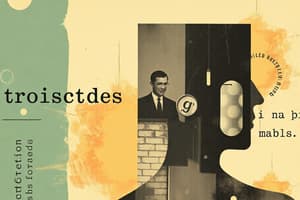Podcast
Questions and Answers
Which type of verb is a transitive verb?
Which type of verb is a transitive verb?
- Helping Verb
- Intransitive Verb (correct)
- Linking Verb
- Descriptive Verb
What is the main function of a direct object in a sentence with a transitive verb?
What is the main function of a direct object in a sentence with a transitive verb?
- Describes the subject
- Acts as a linking verb
- Takes the action of the verb (correct)
- Provides clarity to the sentence
Which of the following words can be used as a transitive verb?
Which of the following words can be used as a transitive verb?
- Run
- Drive
- Sleep (correct)
- Jump
In the sentence 'Adorlee stopped the car.', what type of verb is 'stopped'?
In the sentence 'Adorlee stopped the car.', what type of verb is 'stopped'?
What is the function of 'feels' in the sentence 'Maria feels excited for tomorrow.'?
What is the function of 'feels' in the sentence 'Maria feels excited for tomorrow.'?
What type of verbs are often seen as linking verbs?
What type of verbs are often seen as linking verbs?
What determines whether a verb is transitive or intransitive according to the text?
What determines whether a verb is transitive or intransitive according to the text?
In the grammatical structure 'Neil (subject) + caught (transitive verb) + the ball (direct object),' the verb 'caught' is classified as:
In the grammatical structure 'Neil (subject) + caught (transitive verb) + the ball (direct object),' the verb 'caught' is classified as:
Which of the following is NOT an example of an intransitive verb?
Which of the following is NOT an example of an intransitive verb?
In the sentence 'Aaliyah (subject) + read (transitive verb) + a book (direct object),' the verb 'read' is classified as:
In the sentence 'Aaliyah (subject) + read (transitive verb) + a book (direct object),' the verb 'read' is classified as:
Flashcards are hidden until you start studying
Study Notes
- Neil is the subject of Sentence 1, identified by being the noun taking the action before the predicate.
- The verb in Sentence 1 is "caught," which cannot stand alone as the predicate and requires a direct object.
- The direct object in Sentence 1 is "the ball," identified as the item Neil caught.
- The grammatical structure of Sentence 1 is "Neil (subject) + caught (transitive verb) + the ball (direct object)."
- Aaliyah is the subject of Sentence 2, identified by being the noun taking the action before the predicate.
- The verb in Sentence 2 is "read," which cannot stand alone as the predicate and requires a direct object.
- The direct object in Sentence 2 is "a book," identified as the item Aaliyah read.
- The grammatical structure of Sentence 2 is "Aaliyah (subject) + read (transitive verb) + a book (direct object)."
- In Sentence 3, "Stephanie" is the subject, identified as the noun taking the action after an adverbial phrase.
- The verb in Sentence 3 is "rode," which cannot stand alone as the predicate and requires a direct object.
- The direct object in Sentence 3 is "her horse," identified as the item Stephanie rode.
- The grammatical structure of Sentence 3 is "When the sun set (adverbial phrase), + Stephanie (subject) + rode (transitive verb) + her horse (direct object) + to the store (prepositional phrase)."
- A transitive verb requires a direct object and cannot stand alone as the predicate, while an intransitive verb does not require a direct object and can stand alone as the predicate.
- Examples of intransitive verbs include "stands," "sleeps," and "stops," which do not require a direct object to complete the action.
Studying That Suits You
Use AI to generate personalized quizzes and flashcards to suit your learning preferences.




